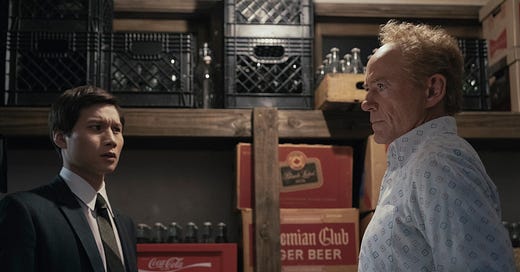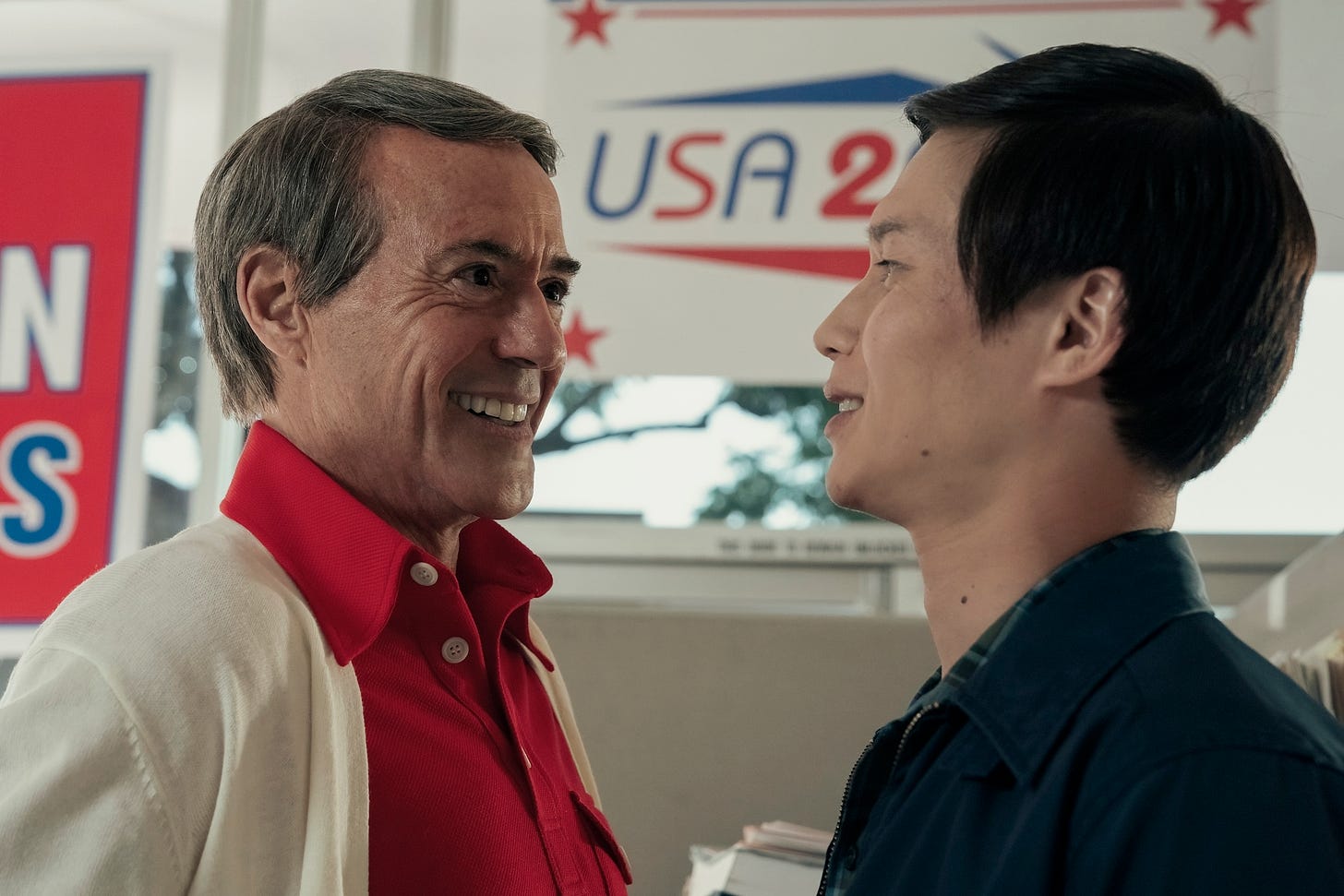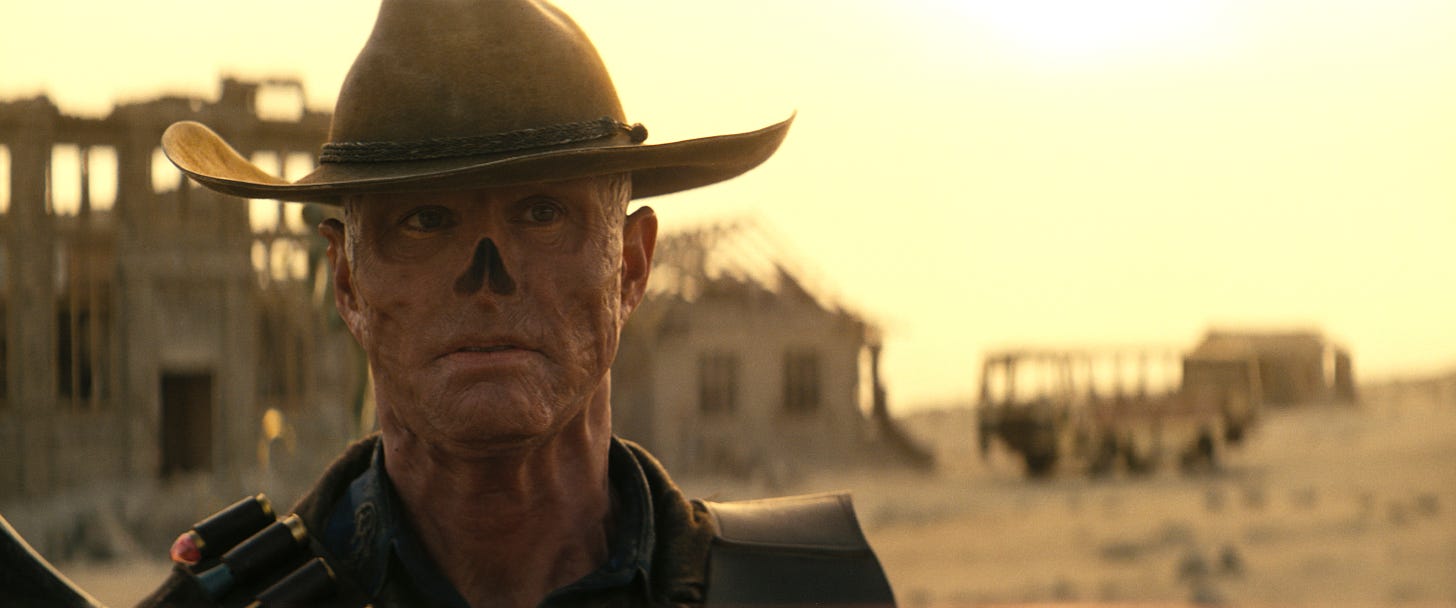'Sympathizer,' sympa-'Sympathizer,' you're a 'Sympathizer'
Plus, the 'Curb Your Enthusiasm' finale, 'Ripley' spoilers, 'Fallout,' and more
This week’s What’s Alan Watching? newsletter coming up just as soon as everything goes catawampus…
System of a Downey
Around the time it won the Pulitzer Prize for literature, I borrowed Viet Thanh Nguyen’s The Sympathizer from my local library, began reading and enjoying it, then got distracted by something else, had to return it, and for whatever reason never thought to check it out again. (This happens to me more often than it should, including with old movies that I start and forget to finish.)
So I went into Park Chan-wook and Don McKellar’s seven-episode HBO adaptation of the book with minimal spoilers, and without unreasonable expectations. And I really liked it. It’s not perfect, and I particularly ran hot and cold on Robert Downey Jr., who plays multiple characters in a variety of Philip Jennings-level wigs and prosthetics. (He will almost certainly win an Emmy for this, and I will just pretend that he’s instead belatedly winning it for the season he spent on Ally McBeal.) But Park is a hell of a visual storyteller, and I really liked Hoa Xuande in the underwritten lead role. It’s among the year’s TV highlights so far.
And, like Shōgun (which I’ll write about again in the next week or two), it’s an example of a continuing, welcome trend of major TV outlets growing unafraid of subtitles. There’s a lot more English here than there is in Shōgun, but significant passages occur entirely in Vietnamese, and the question of language actually becomes a key emotional theme of the show. Very interesting stuff all around.
The Curb verdict is in: Guilty
So, the Curb Your Enthusiasm finale was exactly what we thought it would be: Larry David the showrunner remaking the Seinfeld finale by putting Larry David the character on trial, just because he could, and even titling the episode “No Lessons Learned” to underline his intentions.
Honestly, I would admire the spiteful approach to this if I had found the episode funnier — or, really, funny at all. The problem is that there should have been a lesson learned from the end of Seinfeld, which is that parading out minor characters to remind us — in both dialogue and old clips — of funny things from old episodes isn’t funny in and of itself. And the new comedy bits, like Allison Janney lying about the highway incident with Larry, or Larry undermining his attorney, felt as half-baked as most of the material from this season.
And also: how do you do an episode that’s a blatant rehash of an infamous Seinfeld episode, include a subplot about Leon finally watching Seinfeld, and at no point have Leon — or, really, anyone up until the late conversation between Larry and Jerry — comment on the similarity? It seems like such an easy kind of joke to craft. Although maybe not, given the rest of the episode.
Curb is far from the first once-great series to stumble to the finish line. Nor will it be the last. It’s hard, though, to imagine any future series making 12 seasons period over twice as many years. Heck, it’s hard to imagine all but a few scripted shows getting anywhere near 12 seasons in the new TV economy.
Odds and/or ends
While I really enjoyed interviewing Fallout star Walton Goggins again for a story that ran last week, my enjoyment of Fallout itself was substantially lesser. It succeeds in turning the games into a television show; it’s just a fairly mid show at best, even with Goggins doing his thing as entertainingly as always.
One story I wrote this week, but that won’t be available for a few days, is about Sunday’s release of “The Sign,” a Bluey special that has the show’s enormous fanbase alternately thrilled, because it’s four times longer than a regular episode, and terrified, because they worry it’s meant to be a series finale. I have no comment on the latter, but I will say that this column has the most Sepinwall sentence I have ever written, and probably will ever write.
What is dead may never die in the IP-driven era of television. But even by the standards of this era, what happened Wednesday was pretty ridiculous. Within hours of each other, news broke that revivals of both Heroes and Melrose Place were being developed. Unless you are a TV reporter or a serious amateur TV nerd, odds are you don’t know or recall that both of those shows were already revived once before: Heroes with the short-lived Heroes Reborn in the mid-2010s, Melrose Place on the CW a few years before that. The audience didn’t care about these brands a decade ago or more; viewers are going to have even less interest in them now, assuming either gets made. In general, it seems the enthusiasm for these things has waned a lot; NBC just canceled the new Quantum Leap after two seasons, and it might have only lasted one if the network didn’t need strike insurance programming. Pair that with how — with some exceptions like Shōgun — most of the big breakout shows in recent years have been original concepts like The Bear and The White Lotus, and maybe at some point it will occur to someone in the business that IP Above All is not the wisest strategy? Probably not, but a boy can dream, can’t he?
Ripley: Believe it… or not
Finally, now that many of you have had an opportunity to watch Ripley in its entirety, I wanted to touch on some parts of the show that I didn’t want to write about in my original review, for fear of spoiling some of the fun:
First, we have to talk about Dickie’s murder on the motorboat — more specifically, about Ripley’s difficulty hiding both the body and the boat. As I’ve said, inconvenient corpse disposal is about as tired a trope as there is in the prestige drama game, as if everybody watched the first few Breaking Bad episodes, and/or the “Whoever Did This” episode of The Sopranos, and assumed they had to try something similar, but without the patience or imagination to match. But good lord, was there patience here. The struggle to untie the anchor rope, followed by Tom practically burning half the boat, followed by Tom getting knocked into the water and repeatedly hit and endangered by the circling boat, was so detailed, and simultaneously so scary and funny, that I practically applauded by the time it was done. And, for that matter, I loved Tom’s struggles to get Freddie’s body out of his apartment building. Vince Gilligan loves to talk about those Breaking Bad episodes as representative of “the in-between moments” that separated that series from so many other crime stories. Steven Zaillian definitely understood that the only way to do this was to sweat every last detail, and to ensure that the audience was eventually sweating, too.
I complain a lot about overly-restrictive Do Not Reveal lists. So it feels worth noting that Netflix not only didn’t put the presence of John Malkovich — who played Ripley himself in 2002’s Ripley’s Game — on its DNR list, but actually included his name in many press releases. I suppose so few people saw or remember Ripley’s Game that it wouldn’t be a big deal to all but the most hardcore Patricia Highsmith fans. I had missed his name in prior announcements, so I was excited to see him pop up as a fellow con man who instantly recognized Tom as one of his own kind. If Netflix were to make more seasons, I would hope Malkovich can return.
The casting of Eliot Sumner as Freddie was a really interesting choice. When I saw the first interaction between Tom and Freddie, I wondered if Tom’s extreme discomfort was because Freddie was meant to be non-binary (like Sumner), or queer in some other way that would put the closeted Tom into an extreme defensive mode. But it quickly became clear that Freddie was still meant to be a cis male, just like previous versions, and that Tom didn’t like him out of both jealousy of Dickie’s friendship with Freddie, and an instant recognition that Freddie could see right through him. Following in Philip Seymour Hoffman’s footsteps is perhaps the most impossible task of anyone in this show, because of how Hoffman just exploded off the screen in the 1999 movie. Going for such a different type of actor, and presenting this Freddie as more sly than bombastic, was a smart choice, and Sumner acquitted themself very well.
Because the plot in the later episodes was relatively straightforward compared to the Anthony Minghella version, and because there’s no real emotional arc for this wholly sociopathic version of Tom, I would argue that Zaillian could have trimmed this by an episode or two without losing anything major. And because we see Inspector Ravini’s investigation play out at length, I was more bothered by how that was resolved than if it had been fairly compressed. Specifically, I didn’t buy that Ravini would be fooled by Tom’s disguise (itself very much from the Philip Jennings catalog), regardless of the lighting conditions. And it felt too contrived that Marge would just happen to pick a photo that didn’t show Dickie’s face to accompany her article. That said, the show’s closing moments, where Ravini sees what Dickie really looked like, and asks someone to spell the name Ripley, followed by it being typed out on the screen as Tom poses for photographs, was as delightful an ending as I’ve seen in any show for a while.
That’s it for this week! What did everybody else think?









Curb finale was fantastic and the entire last season was incredibly good.
We finished Ripley yesterday and really enjoyed it. I don't know if you read the book, but my memory is that it stuck pretty close to it, both in the level of detail it awarded to Tom and the meandering way the case circles around him. And I don't think this is a spoiler, but the next book (Ripley Under Ground) deals directly with art forgery, so I feel like Malkovich's involvement and the allusions to art forgery are both an easter egg for readers of that book and a possible setup for a sequel. Which hopefully we get, because that one is my favorite of the Ripley books.